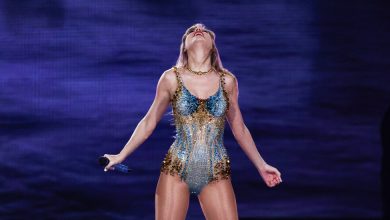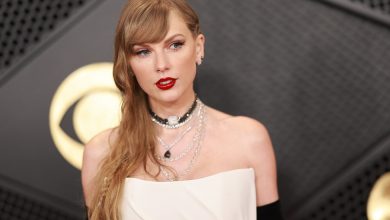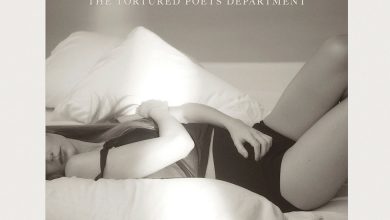Bicycle Diaries: Cruising With the ‘American Utopia’ Family

On a dock in Queens, David Byrne’s musical bike gang was gearing up to go.
“Are we ready?” Byrne called.
It was a Saturday in late August, and the gang — three percussionists, a guitarist, a bassist and me, along with a daredevil photographer and lighting assistant — were sitting astride bicycles as Byrne, our fearless two-wheeled leader, outlined the plan.
He wore a brimmed, pith-style helmet and a tour guide’s relaxed confidence: He’d done this route before, from Astoria to Flushing. The destination was the Queens Night Market, a paradise of global food stalls at the site of the 1964 World’s Fair. He’d already been talking up a ceviche stand and the all-women samba drumline he’d seen the last time he’d pedaled through.
The market, in its diversity, “is really extraordinary,” he said — the kind of endeavor that seems like an antidote to our current social divisiveness. “In that context, you really go, ‘OK, this is not impossible, we can do this.’” It’s a message of community-as-uplift that Byrne, the former Talking Heads frontman, has been big on recently, with his hit theatrical concert “American Utopia,” a mostly joyous pilgrimage through his music. Even the act of extreme weather that ultimately derailed our ride didn’t curb his ability to find revelation locally.
Byrne is, of course, a devoted cyclist: He’s written a book about it, and even designed bike racks; last week, he took an e-bike to the Met Gala (so he wouldn’t get sweaty!) and checked his helmet at the door. In the Before Times, I could sometimes clock the velocity and verve of my nightlife by how frequently I intersected with him speeding to some event along the Williamsburg waterfront bike path. He was easy to spot, often dressed in somehow still-pristine white — as he was on this evening, stepping off the East River ferry in white pants, a blue guayabera shirt and brown fisherman sandals. His whole crew, castmates from “American Utopia,” had been onboard, too.
On the dock, he gave a few general instructions — hang a left at the big brick building, “go down for, like, a couple miles; should I say when our next turn is? Sixty-first, we make a right” — and then we peeled off. In interchanging pairs or spread out, our expedition took up half a city block. “Riding in New York is — hoo-hoo!” trilled Angie Swan, the guitarist, who had moved here from Milwaukee to work with Byrne and was now dodging through a crowded bike lane.
It was the weekend before rehearsals began for the Broadway return of “American Utopia.” But the cast had already been convening throughout the pandemic for these miles-long, leisurely (or not) bike rides around town, led by Byrne, who is 69 and has the stamina of an athlete and the curiosity of a cultural omnivore. Queens, the Bronx, Staten Island: He traversed the city a couple of times a week at least, trailing bandmates alongside him.
“That kind of pioneering spirit that he has in music is the same as he has in his bike rides,” Jacquelene Acevedo, a percussionist and Toronto transplant who lives in Brooklyn, said as we pedaled along, passing beneath the rumbling train and only-in-Queens intersections like the corner of 31st Avenue and 31st Street. She said she got to know the city on these socially distanced rides. “We would go on these adventures,” she said. “It’s great. You come back six hours later, exhausted, like, ‘Where did I go?’”
That Saturday, we pulsed through Jackson Heights toward Corona — two neighborhoods, Byrne observed later, that had been hit hard, early on, by the coronavirus — and saw the city’s rhythms change. We spun through families barbecuing on pedestrian blocks and dinged our bells along to the streetside cumbia and reggaeton. It was, in a word, glorious.
We might’ve blown a few stoplights, too, and caused some double-takes as Cole Wilson, the photographer, and his assistant, Bryan Banducci, cycled ahead of the group but peered backward to get their shot. Byrne was always in the lead; as soon as traffic disappeared, he removed his helmet, revealing his signature silver coif.
By the time we landed in Flushing Meadows Corona Park, the sun was setting. Byrne led us to his ceviche spot. Moments later, the skies opened up: Tropical Storm Henri, arriving far earlier than the forecast predicted. We were quickly drenched. So, so drenched.
A night that was meant to be a dreamy celebration of this multicultural city and its serendipitous connections, experienced from atop a bike seat, wound up in a (very) soggy group subway ride home. But even that became a moment for Byrnian wonder, thanks to a subway preacher and her acolytes, and an unexpected bit of ecstatic dance — the civic and the divine aboard the 7 train. Byrne clocked it all, surrounded by his bikemates.
This group of musicians had toured with “American Utopia” when it was a more traditional rock concert a few years ago, and their matching bikes — a folding model made by Tern — came along then, too. The bikes had their own compartment on the tour bus: “Even when we went overseas, the bikes would come,” said Tim Keiper, a drummer. They would sometimes ride 25 miles before soundcheck, added Daniel Freedman, another drummer. (There are more than four dozen percussion instruments in the show.) “David would find the cool thing,” Freedman said, “and be like, there’s a restaurant or a museum or something bizarre, funny — ‘Cumming, Iowa! We’ve got to go!’”
For Byrne, the rides kept him “sane on the road,” he told me later, “and inspired and stimulated.”
It also gave his cast and crew a connection that was rare among performers. The original run of “American Utopia” ended in February 2020, just before the coronavirus shut down the city’s live performance spaces. During lockdown, Annie-B Parson, the show’s choreographer, saw the “American Utopia” crew a lot more than anybody else, she said. The cast’s emotional closeness onstage? “It’s not acted.”
“Bike riding is a nice metaphor,” she added, “because there’s a kinship. There’s a group moving together, but everybody’s in their own space. But there is a unison. It’s a dance, for sure.”
Days after drying out from the Queens ride, the group gathered for rehearsals. “American Utopia” is now playing at the St. James Theater, a bigger Broadway venue than its previous home, the Hudson. Parson, a downtown choreographer known for her attention to form and multimedia detail, was thrilled to learn that the stage is a rectangle, as she’d originally envisioned for the piece. “To me, a square shape is a warm shape that faces in, because there’s symmetry on the sides,” she explained. “A rectangular shape implies infinity, because it reaches out on the sides. They’re both beautiful. This show, and David, to me, I associate with a rectangle.”
So Parson polished the choreography, much of which is done by the musicians while they’re playing. (Chris Giarmo and Tendayi Kuumba, standouts onstage and in Spike Lee’s filmed version of the show, are the main dancers.) In one rehearsal, Parson directed Byrne to amplify a moment by turning to face his castmates, giving an extra beat of connection there — the pandemic had underscored a theme of the show, “that we’re not atomized entities,” Byrne said. “Being together with other people is such a big part of what we are as individuals.”
As a collaborator, Byrne leads with praise. Watching his percussion circle, he danced along with his very core. “I love the first half where you change up the groove, but it still keeps all the momentum,” he told them.
In Byrne’s recent eclectic career, “American Utopia,” which will receive a special Tony Award at this Sunday’s ceremony, has taken up a bigger chunk than other projects. It may be because it makes him happier. “It’s a very moving show to do,” he said, “and a lot of fun” — not least because audiences shimmy with abandon a few songs in.
And it pulls from the panoply of Byrne’s interests. There’s neuroscience, civic history, and Brazilian, African and Latin instrumentation. The visual and movement references span the world: the Bauhaus artist Oskar Schlemmer; ’70s Japanese movies; a Thai king’s coronation; and, after our Queens odyssey, a scene from the 7 train, when a woman pulled out a mic and an amp, plugged in and began proselytizing.
Byrne, unrecognized beneath his mask, stood near her, holding his bike. Across the way, her companion suddenly began doing impassioned hand motions that were reminiscent of some “American Utopia” moves, waving and snapping her wrists around her face. “Annie-B should see this!” Byrne said, almost to himself. Someone taped a snippet, and he sent it off to her to check out.
“There are no words to describe how adventurous David is,” Parson said. “He always finds the most profound way to interact with a place with his bicycle, and he always invites others, graciously, to join in.”



